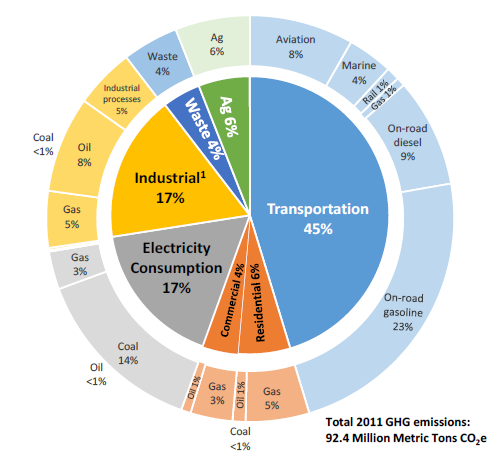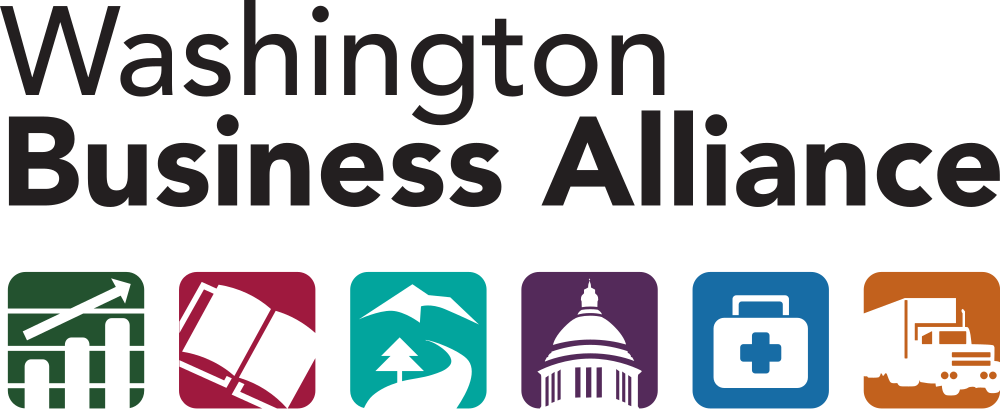by Hans D. Stroo on December 1, 2014
Bolstered by growing public support for climate action, international, federal, state, and local governments are considering a suite of policies aimed at reducing greenhouse gas (GHG) emissions. Washington’s unique clean and competitive energy assets position the state to succeed in a well-designed regulatory climate encouraging the use of less carbon intense energy sources. Businesses in Washington State have a leadership opportunity to drive a policy outcome where real reductions occur and the economy thrives.
Governor Inslee’s Climate Emissions Reduction Taskforce (CERT) was the latest effort to examine carbon pricing. The taskforce was charged with answering a tactical policy question: What kind of carbon price do you prefer, Cap & Trade or Carbon Tax? For good reason, the final report fell short of making a clear recommendation. Achieving state emission reduction targets with either strategy would require adopting and sustaining a comprehensive carbon pricing program, the economic impacts of which are entirety dependent on how new revenue is spent. Further complicating the discussion is an unclear implementation pathway—could legislation pass or would it require a ballot initiative?
The organization CarbonWA is advocating for an alternative but similar, British Columbia-style revenue neutral carbon tax policy which starts low, grows incrementally, and would offset energy price increases with rebates and reductions in other taxes. The approach has strong merit as a good tax/bad tax swap, but relying on a carbon tax to reach Washington’s statutory emission goals would be challenging. Only a high carbon price, in excess of $50/tonne, will materially alter electricity generation given the dispatch order of plentiful, cheap coal and natural gas. Transportation fuels are relatively inelastic, similarly requiring a high price and long-term commitment to meaningfully impact emissions. You can view the modeled impact of several carbon tax scenarios by following this link as well as some helpful lessons learned from Australia’s experience at this link.
In search of a solution that drives emissions reductions today and appeals to the broadest coalition of stakeholders, the Washington Business Alliance (WaBA) asked a different question:
How do we reduce carbon emissions and have a vigorous economy?
WaBA identified the major sources of carbon, baseline projections, current policies, and trends and pinpointed the technology-enabled pathways to reduce carbon while driving economic prosperity.

Washington State Department of Ecology data published by the state’s Carbon Emissions Reduction Taskforce.
Early conclusions were organized into the Technology-Enabled Market Strategy, which aims to meet Washington’s GHG emissions reduction targets set by the Washington State Legislature in RCW 70.235.020: to reduce emissions to 1990 levels by 2020 and 25% below 1990 levels by 2035. Though the state’s goals include 2050, we’re focusing on 2035. This goal is consistent with WaBA’s own initiative, PLAN Washington, which set a goal for Washington to be among the top five states in carbon competitiveness (CO2 emitted per million $ of GDP) by the year 2025. Washington currently ranks 7th.
- Electricity: Build on our state’s natural advantage, leveraging what is among the cleanest and most competitive electricity mixes in the nation.
- Energy Efficiency: Private sector expertise, tighter building codes, and recovered waste energy ‘free up’ resource capacity for use elsewhere, especially transportation.
- Transportation: Stimulate the use of low carbon electricity and fuels in transportation, the largest source of Washington’s emissions.
Electricity
Washington’s hydropower resources provide the state with the lowest combined electricity price across all sectors and one of the least carbon intense electricity mixes in the nation. Maintaining this competitive edge is key to preventing leakage which may send jobs to less-clean states and countries, providing a net negative effect on global carbon. Washington State Office of Financial Management, Revised Draft Report: A Clean Fuel Standard in Washington State, October 29, 2014.
Partially derived from fuel disclosure reports made available by the Washington State Department of Commerce.
Attempting to further discourage fossil fuel consumption by increasing the price of electricity can hurt Washington’s competitive advantage and result in diminishing returns. Without a carbon price, market forces and regulation are already discouraging the use of coal and accelerating the transition to less carbon intense energy sources. By 2025, Washington State’s largest emitter, the Centralia coal-fired power plant, will close, eliminating coal generation from Washington’s domestic electricity mix. This will reduce Washington’s grid emissions rate by 38%, accounting for over half of Washington’s emission rate reduction required by the EPA’s pending 111(d) rule. Furthermore, Governor Jay Inslee has instructed the Utilities and Transportation Commission and the Northwest Power and Conservation Council (NWPCC) to regulate coal-by-wire. By 2020, increases in production will make the U.S. a net natural gas exporter. For consumers, a switch to cleaner electricity—specifically natural gas for thermal generation—will minimally impact electricity prices.
Energy Efficiency
Conservation and energy efficiency make Washington more competitive and “free up” resources, especially electricity, to be used elsewhere. The NWPCC projects that conservation can provide 85% of the Northwest’s load growth until 2030. The return on energy efficiency investments is compelling, independent of carbon reduction benefits, and can be as low as half the installed cost of new natural gas combustion or Columbia Basin wind power.
The local energy efficiency knowledge base includes organizations such as: Seattle’s 2030 District, WSU Extension Energy Program, The Bullitt Center, New Buildings Institute, and the International Living Future Institute. Together with companies such as MacDonald Miller, NBBJ, and O’Brien & Co, Washington possesses deep construction, design, and production expertise.
* Washington State Office of Financial Management, Revised Draft Report: A Clean Fuel Standard in Washington State, October 29, 2014.
Transportation
The transportation sector is responsible for 45% of Washington’s emissions, and 55% of Washington’s wasted energy. The greatest long-term opportunity to reduce GHG emissions in transportation is improved vehicle efficiency through electrification followed by a shift to low carbon electricity and fuels. Fuels that are lower in CO2 are considered less carbon intense—allowing the same vehicle and airplane miles traveled with fewer emissions.
Electrification reduces emissions in two principal ways. First, Joule-per-Joule, Washington’s average electric mix is ¼ as carbon intense as onroad gasoline. Second, electric vehicles use energy more efficiently, reducing total energy use by more than 75% when compared to conventional, internal combustion vehicles.
Policy Opportunities
- Electricity
- Support a fuel switch from coal to less carbon intense energy sources in Washington’s electricity mix.
- Encourage investment in grid enhancement (e.g. smart grid, load-balancing storage), enabling integration of intermittent renewable energy generation and transportation electrification.
- Support formation of joint select task force to explore nuclear energy.
- Energy Efficiency
- Make building energy performance ratings public.
- Examine role of decoupling and Time-of-Use electricity rates.
- Encourage use of outcome-based building codes, “renewable ready” construction, transit-oriented development, and other green building policies with waived permit fees, accelerated approval, or density permits.
- Normalize building codes between state, counties, and local jurisdictions.
- Pursue funding for cost-effective residential energy efficiency and weatherization programs.
- Transportation
- Increase electric vehicle and charging installation incentives to reflect contributions to conservation and emissions reductions.
- Accelerate low carbon transportation, emphasizing technologies, solutions, and fuel pathways that are available today and benefit the state, including: electricity, compressed natural gas, and biofuels—with special attention to locally-sourced landfill/waste-derived gas, biodiesel, and forest-derived ethanol.
WaBA has dedicated resources to investigating opportunities in the low carbon economy—the technologies as well as potential policies—and is partnering with businesses and organizations who know each sector intimately in order to detail what needs to be done and how it can be accomplished. To contribute to developing the strategy please email: info@wabusinessalliance.org.
The Washington Business Alliance is a nonpartisan, nonprofit organization of businesses and business leaders committed to the vision of a state where businesses thrive and residents enjoy a high quality of life. Its chief initiative is called PLAN Washington: a vision for Washington in the year 2025 and a policy roadmap for getting there.
